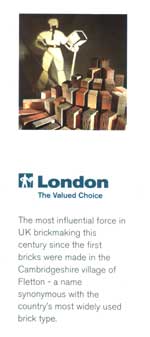At sometime during 1881 the group of brickmakers in the area discovered the very special properties of the clay. Credit is usually given to the Hemsted brothers but this is not clearly documented. A local draper, James McCallum Craig also owned brickworks in the area and may have been responsible. Bricks had been made from the surface clay but for the first time the lower clay was used. The discovery that the clay itself burns was the start of the revolutionary process to change the history of brick making.
There are several advantages to this type of clay for the brickmakers.The first obvious one is that the clay itself is part of the fuel needed to fire the bricks. The clay contains a high carbonaceous material. Once heated, it burns at sufficently high temperature to fire itself. Less coal is needed making the whole process more economical in all respects - time, resources and manpower.
Another advantage is that the shaley lower clay , known as Knotts, is of superior quality. Bricks made from the surface layers of clay are too soft. The very lowest clay has been found to contain too much lime which damages the kilns during firing. The shaley lower clay, actually the middle layer, is easier to extract as it lays in huge seams over 100 feet deep in places. It is also of a unifom consistency requiring less kneading once extracted. In addition it has few impurities and the correct lime content to prevent cracking during firing.
The third advantage is the natural moisture content. This is between 16-20% and meants water doesn't have to be added as with other clays. It only requires heavy grinding by machine into a powder before pressing into bricks. The water content provides a low level of plasticity and makes the unfired 'green' bricks strong enough to stack in the kiln without intermediate drying. This means less handling providing savings on both time and labour.
All of these factors combined to give the first Fletton brickmakers the competitive edge to push their industry forward. The same properties today make the Fletton brick the most widely used brick


